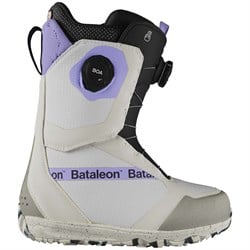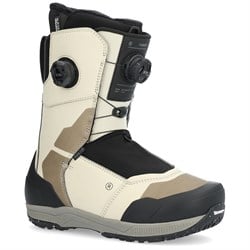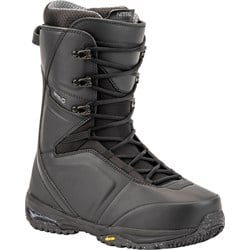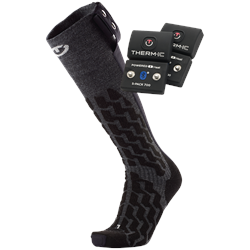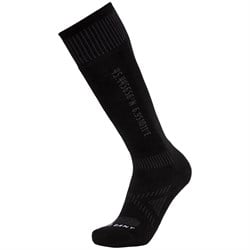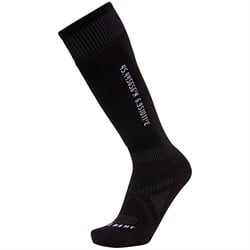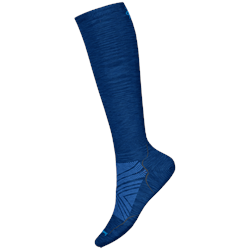By: evo Staff | Last Updated: October 14, 2024
How Should Snowboard Boots Fit?

Snowboard boots should fit snugly, but not to the point where they cause pain. Most boots need several days of riding for them to pack out and form to their true size, and as a result should be fairly tight when brand new.
In a good fitting boot your toes will gently graze the boot’s toecap and you should be able to wiggle your toes inside the boots. Heel hold is another important factor. When your knee is driven forward your heel should remain in place; this is important for board control in toeside turns. Remember that socks also play a part in boot fit - a single thin to medium weight wool or synthetic sock is all you need. There is a fine line between a boot that is too tight or uncomfortable and one that is too loose and gives heel lift. Give our customer care team a call if you have any questions and/or schedule a personalized snowboard boot fitting session with one of our expert boot fitters online today!
How Are Snowboard Boots Sized?
Snowboard boots use traditional US number sizing, but actual boot sizes can vary by manufacturer and even by model within a single manufacturer's line. For example, the outsole of manufacturer A's size 11 might be slightly longer than the outsole of manufacturer B's size 11. Similarly, there are some boots specifically built with a low profile. The shorter outsoles of a low profile boot allows a rider to use a narrower snowboard. Additionally, the ramp angle on snowboard bindings also partially determines how large of a boot you can put on a particular snowboard.
When it comes to compatibility with your snowboard, the size of your boot is important to take into consideration. People with larger (11.5+) and smaller (<7) boot sizes should purchase wider and narrower boards, respectively.

Snowboard Width and Boot Size Chart
| Boot Size (US Men’s) | <8 | 8 - 10 | 10 - 11.5 | 11.5+ |
| Width (mm) | <245 | 246 - 254 | 255 - 259 | 260+ |
| Snowboard Width | Narrow | Regular | Mid-Wide | Wide |
Please note: These are approximations, and do not take into account specific board/boot combinations that may work. Boot overhang is a much better measurement of whether a boot will fit a board. Please see our discussion of snowboard width below for a better understanding of how to find the winning combination!
Snowboard Boot Flex
Snowboard boots have different flex ratings, ranging from soft to stiff. Boot flex is a personal preference but generally a softer flex is chosen by park and beginner riders. For advanced, all mountain riders and freeriders, a stiffer flexing boot is often favored. Boot flex ratings are not necessarily standardized from one manufacturer to the next, so flex may vary from brand to brand. Many manufacturers will give a number rating ranging from 1-10, 1 being softest and 10 being stiffest. At evo, we rate stiffness as a "feel" rating ranging from soft to very stiff. Generally, we class manufacturers' ratings of 1-2 as soft, 3-5 as medium, 6-8 as stiff, and 9-10 as very stiff. Flex ratings and feel may vary from boot to boot.
Snowboard Boot Lacing Systems
Traditional Lacing
Dating back further than Ötzi the Iceman, traditional laces are the tried and true option for your prototypical rider. Easy to use, traditional laces are very customizable but often loosen during the day. Despite this, many snowboarders stick with this classic system for easy lace replacement and a tailor-made fit.
Quick-Pull Lacing
Faster than traditional lacing systems. Many quick-pull lacing systems allow the forefoot and ankle/lower leg to tighten independently from each other, this is called zonal lacing. This type of lacing system is fast, easy, and can be tightened while wearing gloves. There are many different types of quick-pull lacing systems that vary from company to company.
BOA® Lacing
BOA® lacing systems offer fast and easy micro adjustability to your boot fit. BOA® systems use a ratcheting dial attached to a cable. The turning and locking can be done with one hand and also with gloves on. BOA® closures are often offered as a double or even triple system, with one dial controlling the forefoot tightness and one or two controlling the upper cuff tightness.
Types of Snowboard Boot BOA® Lacing Systems
| BOA® Coiler | Central, fast BOA® on the boot tongue |
| Double BOA® | BOA® at the sides of the boot for upper and lower zone tightening |
| Triple BOA® | 2 external for upper and lower zone tightening and a third reel adjusts the liner |
Snowboard Boot Liners
A liner is the inner boot within the snowboard boot and is most commonly made of a lightweight, moldable material called EVA (Ethylene Vinyl Acetate). The liner is an important aspect of the boot construction because it provides the cushioning, stability and insulation you need to ensure comfortable feet on the mountain after long days of ripping. Some liners are removable, while others are permanently attached to the boot. Removable liners can be taken out for speed drying when they get wet.
| Stock Liners | Provide base-level padding and stability and over time will conform to your foot’s shape. |
| Moldable Liners | A step up from stock in price and materials; they are built to mold to your foot shape overtime through body heat. |
| Heat-Moldable Liners | A premium in the boot world that provides a true custom fit for your feet. The heat molding process is best performed by trained personnel like at evo Seattle or evo Portland, evo Denver, or evo Whistler. |

Snowboard Boot Footbeds
A footbed or insole can be used to increase your foot’s comfort level in your snowboard boot. By supporting the natural shape of your foot, footbeds can be a great upgrade to any pair of snowboard boots. While they won't make up for a poorly fitting boot, footbeds can make any boot more comfortable. To choose a proper footbed for both your foot shape and boot, see a bootfitter.
Read More About Footbeds Here >>>
Snowboard Socks
Although they may seem trivial, your choice of snowboard socks can make a big difference in comfort and performance. Snowboard specific socks, made of synthetic materials and/or merino wool that keep you warm and wick moisture away should be standard. Along with synthetic sock materials like polypropylene, wool is an excellent insulator, keeping your feet extremely dry and warm. Cotton socks should be avoided since they don't wick moisture away from your feet, and damp feet = cold feet. Thicker socks and wearing 2 pairs of socks places additional material between you and your board and reduces your feel for the snow - the thick outer shell of the boot and the foam inside normally provides plenty of insulation.

Common Snowboard Boot Fit Mistakes
- Buying boots that are too big. See Fit Section
- Taking advice from friends about boot fit/size. Friends may give you what they think is great advice about boots that work for them. While we aren’t saying you should call your friend a liar, you should take into account that their foot size and shape is probably different from yours. Boots that work great for them may not necessarily work for you.
- Snowboarders often spend the majority of their budget on the board and bindings while letting their boot considerations go to the wayside. Finding the right boot shouldn’t necessarily be about price, but instead should emphasize fit and comfort. Buying a boot because it is cheap is potential recipe for discomfort. You don’t necessarily need to buy the most expensive boot for a great fit (see our outlet for great boots at a great value) but making sure that is the case should be your top consideration.
- Buying a boot based on looks alone and not fit.

evo Staff
A collaborative effort from our in-house experts.
The evo employees who collaborated to produce this guide are more than just a group of keyboard warriors, they are experts in their field, devoted snowboarders who are knowledgeable about gear, and have first-hand experience using and abusing the products we recommend. Leaning on the knowledge of our staff bootfitters, buyers, and most veteran snowboarders, we hope to provide valuable insights on choosing the right snowboard boots for you.





